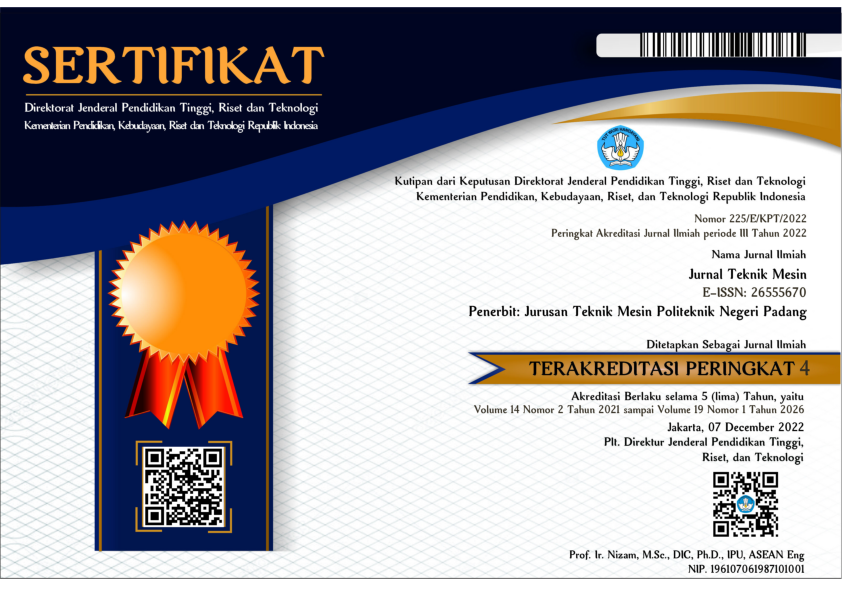Hasil Pengujian Proksimasi Dan Gas Buang Pada Briket Campuran Limbah Serutan Kayu, Sekam Padi Dan Bulu Ayam
Abstract
Biomass energy is one that can be used as an alternative energy as a substitute for fossil fuels and can also be useful for reducing environmental pollution due to increasing waste or waste. The manufacture of briquettes from chicken feather waste, wood shavings and rice husk waste aims to help deal with the problem of waste and use it as an alternative fuel. The making of briquettes is carried out by the process of drying the ingredients, charcoal, milling, sieving, kneading, printing, drying, proximate testing and measuring emissions on the briquettes. In this study, the composition of a mixture of chicken feathers (30%, 40%, 50%), wood shavings and rice husk (35%, 30%, 25%) was treated as well as particle sizes of 30 mesh and 60 mesh. The results of this study indicate that the lowest moisture content is in sample B2 of 4.5%. The lowest levels of volatile matters were in sample A1 of 37.4%. The lowest ash content was found in sample B3 at 10.8%. The highest fixed carbon was found in sample A3 at 45.1%. The highest calorific value (Gross Calorific Value) is found in the B3 sample of 5594 Kcal / Kg. And it has the highest CO, CO2, and HC emissions produced from the briquettes, namely 0.24%, 0.8%, 46 ppm. The properties of briquettes that have met SNI standards are moisture content, calorific value (except for sample A1), and the resulting emissions. And those that have not met SNI standards are the levels of volatile matter, ash content and fixed carbon. The resulting briquette can be used because the calorific value obtained is quiet high, which is above the specified standard of ≥ 5000 Kcal/Kg.
References
Ummi, K.., 2016. Pembuatan Briket Arang Dari Campuran Limbah Tongkol Jagung, Kulit Durian dan Serbuk Gergaji Menggunakan Perekat Tapioka. Jurnal Distilasi, 1 (1), 42-50.
Eddy, E., Purwo, S., dan Ahmad, S., 2014. Analisa Proksimat dan Nilai Kalor Pada Briket Bioarang Limbah Ampas Tebu dan Arang Kayu. Jurnal Aptek, 6 (1), 57-64.
Badan Pusat Statistik, 2017. Luas Panen, Produktivitas, dan Produksi Padi Sawah (GKG) di Kabupaten Karawang. [Online] (Update 4 Jan 2017) Tersedia di: https://karawangkab.bps.go.id [Accessed 23 Mar 2020]
Badan Pusat Statistik, 2016. Populasi Unggas Menurut Kecamatan dan Jenis Unggas di Kabupaten Karawang. [Online] (Update 3 Nov 2016) Tersedia di: https://karawangkab.bps.go.id [Accessed 25 Mar 2020]
Dini, S.M., Risna, T.Y., Heri, M., dan Cahyono, P., 2016. Pemanfaatan Limbah Bulu Ayam Menjadi Bahan Pakan Ikan dengan Fermentasi Bacillus Subtilis. Jurnal Manusia Dan Lingkungan, 23 (1), 49-57.
Alexius, L.O., 2014. Pengaruh Abu Sekam Padi Sebagai Bahan Pengisi Untuk Pembuatan Tungku Rumah Tangga. Jurnal Penelitian Teknologi Industri, 6 (1), 19-30.
Anto, S., dan Tri, Y., 2013. Pembuatan Briket Bioarang Dari Cangkang dan Tandan Kosong Kelapa Sawit. Jurnal Teknologi Hasil Pertanian, 6 (2), 68-81.
Annisa, N.S., Otong, N., dan Sri, S., 2018. Pengaruh Konsentrasi Briket Campuran Sekam Padi dan Serutan Kayu Albasia Terhadap Emisi Karbon Monoksida dan Laju Pembakaran. Jurnal Material dan Energi Indonesia, 8 (2), 25-32.
Laily, N.H., dan Ardhana, R., 2017. Optimasi Kualitas Briket Biomassa Padi dan Tongkol Jagung dengan Variasi Campuran Sebagai Bahan Bakar Alternatif. Journal of Research and Technology, 3 (2), 70-79.
Renny, E.P., dan Andasuryani, 2017. Studi Mutu Briket Arang dengan Bahan Baku Limbah Biomassa. Jurnal Teknologi Pertanian Andalas, 21 (2), 143-151.













